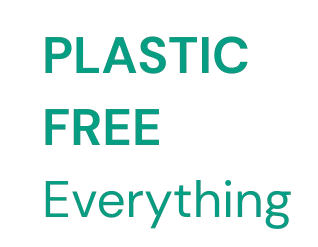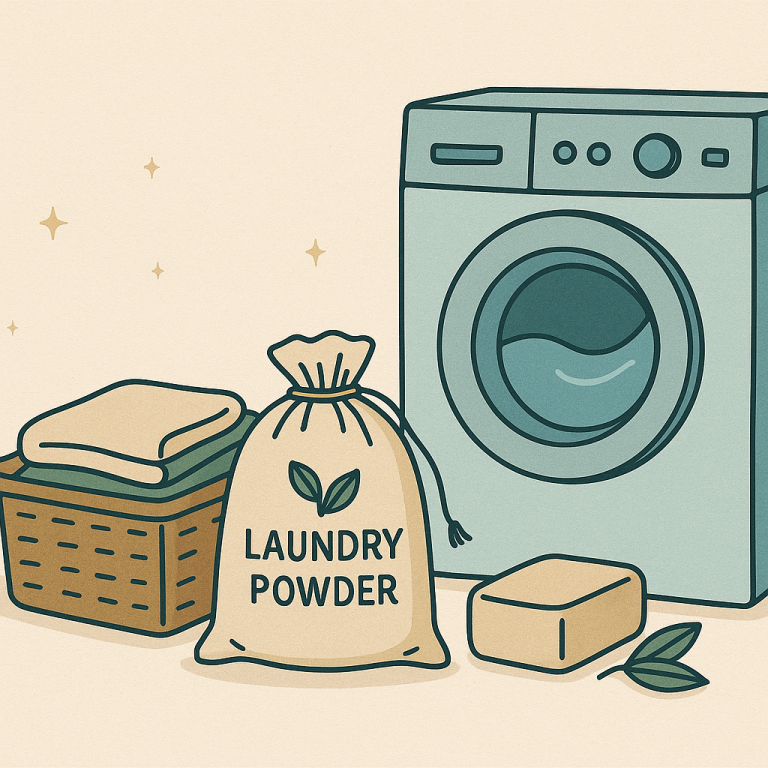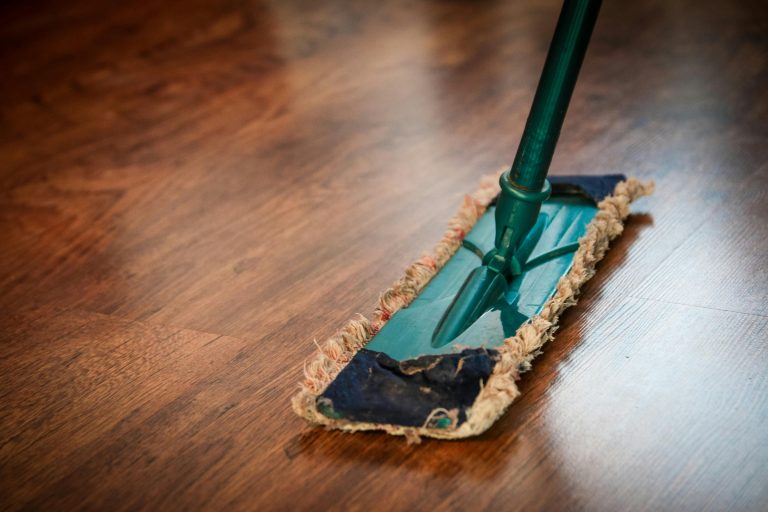Best Compostable Sponges for Plastic Free Cleaning in 2025
Kitchen sponges are essential tools for cleaning dishes, counters, and cookware. Most traditional sponges are made from synthetic, plastic materials that don’t break down naturally and end up in landfills for hundreds of years. These petroleum-based sponges create unnecessary waste that builds up over time.
Compostable sponges offer a better option for people who want to reduce their environmental impact. These sponges are made from natural materials like cellulose, coconut fibers, or plant-based foams that break down completely when composted. They work just as well as regular sponges for everyday cleaning tasks but return to the earth safely when you’re done with them.
The most important factors to consider when choosing compostable sponges are the materials used, how well they clean, and how long they last. Some are made entirely from natural materials, while others have synthetic scrubbing surfaces that need to be removed before composting.
Durability varies widely between different brands and materials. We tested six compostable sponges to find the ones that clean effectively while staying true to their eco-friendly promise.
Best Compostable Sponges
Below is our complete list of the best compostable sponges. We tested each sponge for cleaning power, durability, and how well they break down in compost bins.
| Brand | Materials | Scrubbing Power | Drying Speed | Durability | Price | Notes |
|---|---|---|---|---|---|---|
| Airnex (Our Overall Number 1 Pick) | Cellulose + Coconut Fiber | High | Fast | Moderate (3–4 weeks) | High | Curved shape; coconut layer may peel; recyclable packaging |
| MMG Prime | Cellulose + Coconut Fiber | Moderate | Very Fast | Short (2 weeks) | Mid | Great value in 12-pack; resistant to odors |
| Hasumcol | Cellulose + Coconut Fiber | High | Fast | Moderate | Mid–High | Fibers may shed; separates easily for composting |
| Silkyhose | Cellulose + Coconut Fiber | High | Very Fast | Moderate | Mid | Feels rough at first; S-shaped design |
| SmilePowo | Cellulose + Coconut Fiber | Moderate | Fast | Moderate | Low–Mid | May arrive damp; good for delicate surfaces |
| Kickleen | Cellulose + Coconut Fiber | High | Fast | High | High | Sturdy; stiff at first; ergonomic S-shape |
Overall Top Recommendation: Airnex Natural Sponge

This sponge offers a durable, eco-friendly option that cleans well without the plastic waste.
Pros
- Completely biodegradable cellulose and coconut fiber construction breaks down in compost
- Unique S-shaped design fits comfortably in your hand during long cleaning sessions
- Dries quickly between uses to prevent odor buildup and bacterial growth
Cons
- Coconut scrubber layer can separate and fall off after about a month of use
- Higher price point compared to traditional plastic sponges
- Requires soaking before first use to soften the coconut fibers
After using these sponges for several weeks, we noticed they work just as well as regular synthetic sponges. The white cellulose layer soaks up dish soap nicely and creates good suds. We found the coconut scrubber side effective at removing stuck-on food without scratching our dishes.
The curved shape really does make a difference during extended dishwashing. Our hands felt less strained compared to holding flat rectangular sponges. The materials dry out much faster than plastic versions, which keeps them fresher longer.
We experienced some durability issues with the scrubbing layer. After about three weeks of daily use, the coconut fiber started peeling away from the cellulose base. While this doesn’t affect cleaning performance initially, it does create loose fibers that can be annoying.
The environmental benefits are the main selling point here. When these sponges wear out, we can compost the white portion and dispose of the coconut scrubber responsibly. The packaging is completely recyclable, and the company partners with tree-planting organizations.
Runner Up: MMG Prime Natural Kitchen Sponges

These sponges offer solid cleaning power with true eco-friendly benefits, making them worth buying if you want to reduce kitchen waste.
Pros
- Dual-sided design works well with soft cellulose and scrubby coconut fiber sides
- Completely compostable materials mean zero guilt when throwing them away
- Dry much faster than regular sponges and resist bad smells
Cons
- Won’t survive heavy scrubbing sessions like plastic sponges do
- Cost more upfront than basic synthetic options
- Shorter lifespan means replacing them more often
We tested these sponges on everything from greasy pans to delicate glassware. The coconut fiber side tackles stuck-on food without scratching surfaces. The cellulose side soaks up spills and handles daily dish washing with ease.
What impressed us most was how quickly they dry out between uses. Regular sponges stay damp and start smelling gross after a few days. These natural ones dry completely and stay fresh much longer.
The 12-pack gives you good value since each sponge lasts about two weeks with normal use. When they wear out, we just toss them in our compost bin instead of the trash. The packaging is recyclable too, which shows the company thinks about waste at every step.
We found they work best for regular cleaning tasks rather than heavy-duty scrubbing. Don’t expect them to last as long as plastic sponges if you’re scraping burnt pans every day. For normal kitchen cleanup, they perform just as well as traditional options while being much better for the planet.
Our 3rd Favorite: Hasumcol Natural Compostable Sponges

We recommend these eco-friendly sponges for anyone wanting to reduce plastic waste while maintaining effective cleaning power.
Pros
- Genuinely compostable with separable white cellulose and coconut fiber parts
- Dries quickly without developing the musty smell typical of traditional sponges
- Gentle enough for non-stick cookware yet effective on stubborn grease
Cons
- Small coconut fibers shed occasionally during heavy scrubbing
- Takes more soap to create rich lather compared to synthetic alternatives
- Higher upfront cost than standard plastic sponges
We’ve been impressed with how these sponges tackle everyday kitchen messes. The coconut fiber side removes baked-on food from our cast iron pans without scratching. Meanwhile, the white cellulose portion soaks up spills effectively.
The odor resistance stands out as a major advantage. After washing dishes, we can leave these sponges damp without worrying about bad smells developing overnight. This makes them much more pleasant to use than regular sponges that turn funky quickly.
When it comes time to dispose of them, the process is straightforward. We simply pull apart the two layers and toss the white part in our compost bin. The coconut scrubber goes in regular trash, though it’s still more eco-friendly than all-plastic options.
The 12-pack provides good value since each sponge lasts about as long as conventional ones. We appreciate having backups ready when one wears out from heavy use.
Honorable Mention: Silkyhose Biodegradable Kitchen Sponges
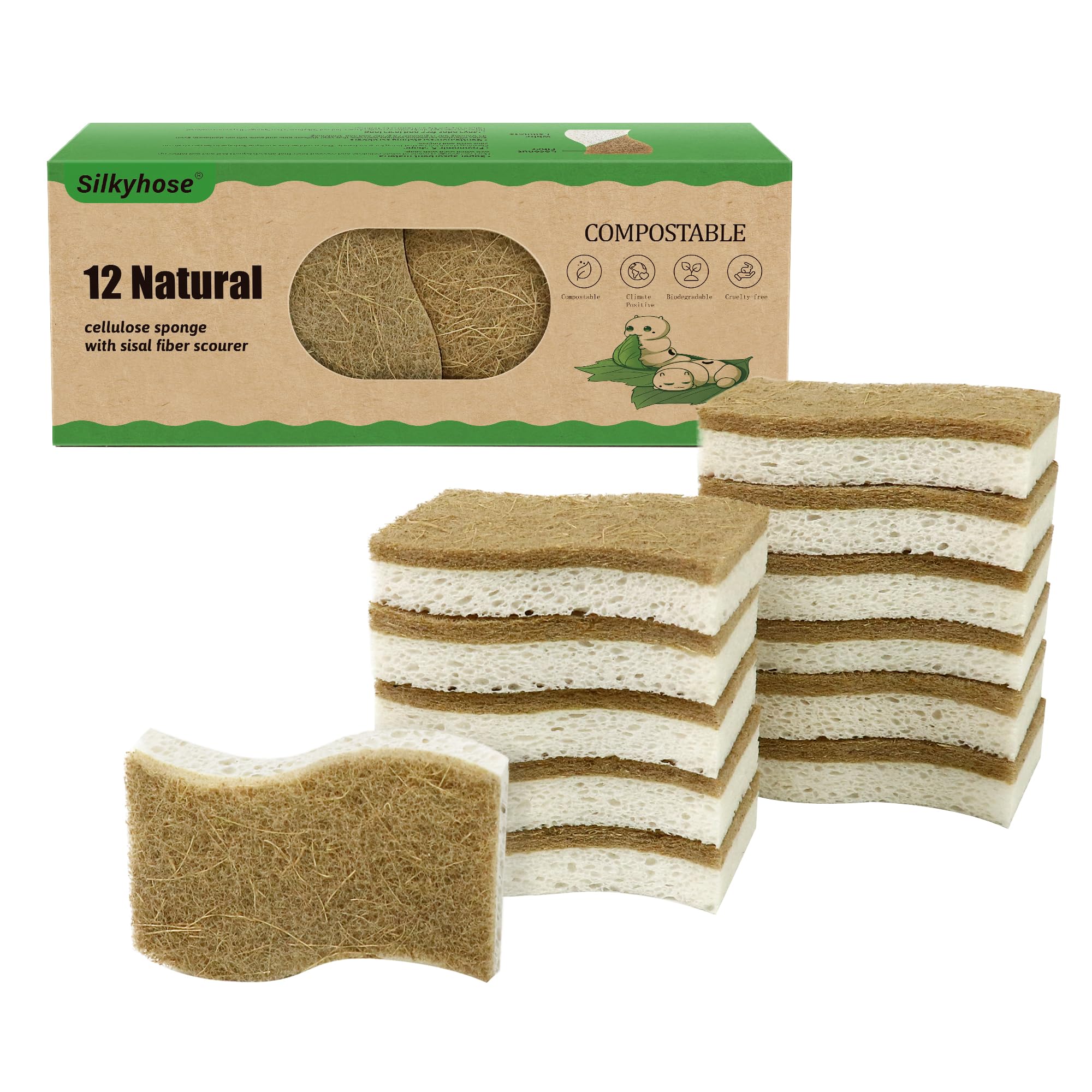
These eco-friendly sponges deliver solid cleaning performance while helping reduce plastic waste in your kitchen routine.
Pros
- Dries quickly and stays fresh without developing bad smells
- The coconut fiber scrubber tackles stuck-on food and grease effectively
- White cellulose material breaks down naturally instead of adding to landfill waste
Cons
- The coconut side feels quite rough at first and might scratch delicate surfaces
- Takes some getting used to if you’re switching from regular plastic sponges
- Initial texture feels different than what most people expect from traditional sponges
We’ve been using these plant-based sponges for several weeks now and they handle our daily dish washing tasks well. The soft side soaks up water and soap nicely while the rougher coconut side removes stubborn food bits from pans and plates.
The S-shaped design fits comfortably in our hands during cleaning sessions. We noticed these sponges air dry much faster than our old plastic ones, which helps prevent that musty smell that builds up over time.
After a month of regular use, our test sponge still holds together and cleans effectively. The white cellulose material holds up better than we expected, even with daily scrubbing of cookware and dishes.
The 12-pack gives us good value since each sponge lasts about as long as traditional options. We appreciate knowing these will break down naturally when we toss them instead of sitting in a landfill for years.
Honorable Mention: SmilePowo Compostable Kitchen Sponges
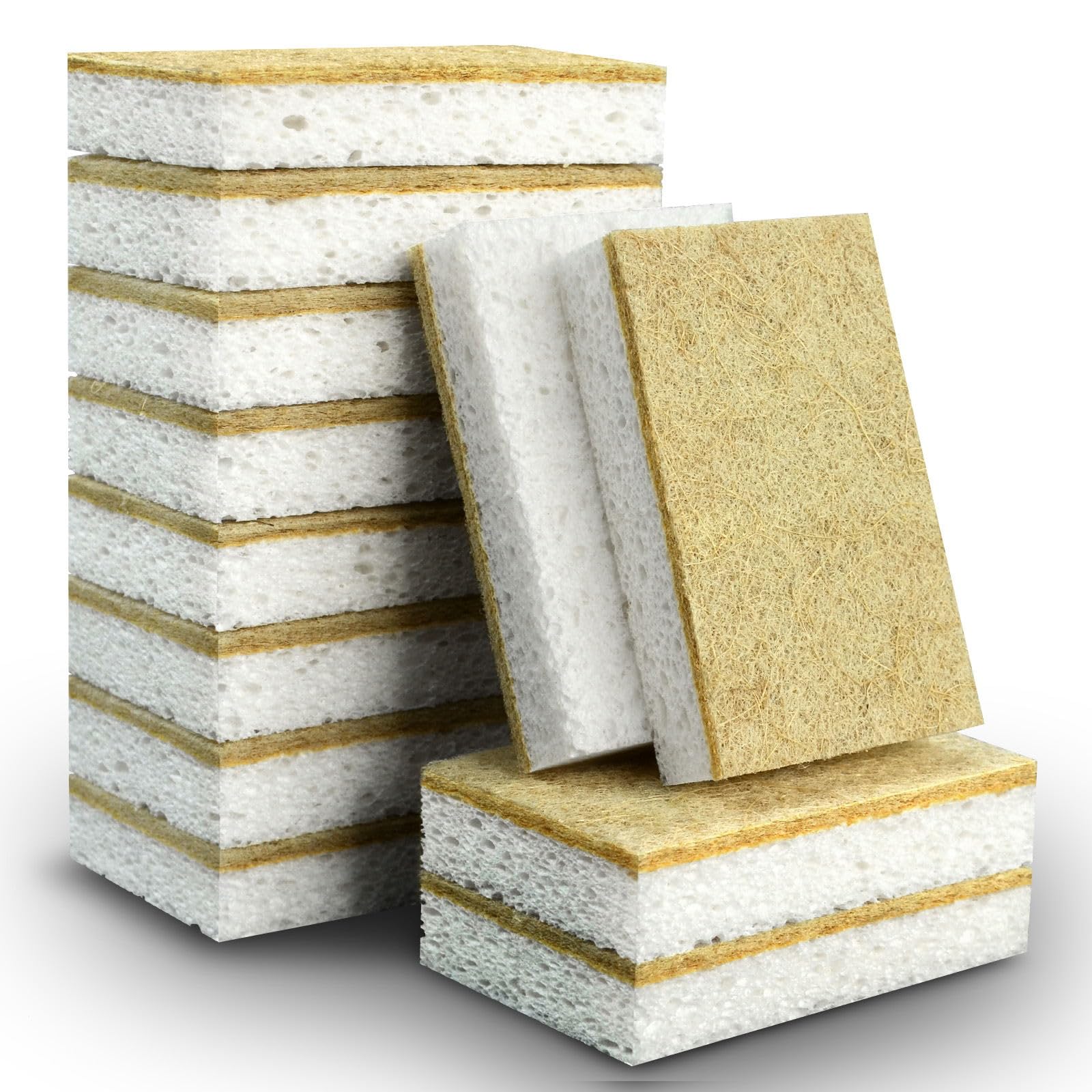
We found these cellulose and coconut fiber sponges to be a solid eco-friendly option that performs well for everyday dish cleaning tasks.
Pros
- Dry quickly after use and resist developing bad smells
- Clean effectively without scratching delicate surfaces like glassware
- Come in a generous 12-pack that provides good value for the price
Cons
- Arrive slightly damp and oily from packaging
- Need to be separated into two parts for proper composting
- May feel different than traditional synthetic sponges at first
When we first opened the package, we noticed the sponges felt a bit damp and had an oily texture. Running them through a quick rinse solved this issue completely. Once moistened for use, they expand to about three-quarters of an inch thick.
The cleaning power impressed us during daily kitchen tasks. We scrubbed greasy pans and delicate wine glasses without any scratching or damage. The coconut fiber scrubber side tackles stuck-on food while the cellulose portion handles general cleaning.
What sets these apart from regular sponges is how quickly they dry out between uses. We noticed far less odor buildup compared to synthetic alternatives. The natural materials seem to prevent bacteria growth that causes that musty smell.
At the end of their lifespan, composting requires separating the white cellulose from the coconut scrubber portion. The extra step takes a moment but feels worth it for the environmental benefit.
Honorable Mention: Kickleen Natural Kitchen Sponges

These eco-friendly sponges deliver solid cleaning performance while keeping your environmental impact low.
Pros
- Natural materials dry quickly and resist bad smells
- Sturdy construction holds up well during tough scrubbing jobs
- S-shaped design fits comfortably in your hand
Cons
- Starts out quite stiff and takes time to soften up
- Scrubbing side can damage delicate surfaces if you’re not careful
- More expensive than regular plastic sponges
We found these sponges work surprisingly well for everyday kitchen tasks. The cellulose side soaks up spills easily and wipes dishes clean without leaving streaks. Food particles come off without much effort.
The coconut fiber scrubbing side tackles stuck-on food better than we expected. However, we learned to test it carefully on non-stick pans first. The scrubber can be rougher than it looks.
What impressed us most was how fresh these stayed after weeks of use. Regular sponges get smelly fast, but these dry out quickly between uses. The natural materials seem to prevent that gross buildup that makes you throw sponges away early.
The unique S-shape takes some getting used to, but it does make scrubbing less tiring. Our hands didn’t cramp up during big cleaning sessions like they do with flat rectangular sponges.
Buying Guide
When we shop for compostable sponges, we need to check several key features. The right choice depends on our cleaning needs and values.
Material Types
Natural fiber sponges break down faster than synthetic ones. Look for cellulose, coconut coir, or loofah materials.
Plant-based options work well for most cleaning tasks. They absorb water and soap effectively.
Durability Features
We should check how long each sponge lasts. Some natural materials wear out quickly with heavy use.
Scrubbing power varies between materials. Coconut fiber offers more scrubbing strength than cellulose.
Certification Standards
Look for these labels when we buy:
| Certification | What It Means |
|---|---|
| ASTM D6400 | Meets composting standards |
| BPI Certified | Approved for commercial composting |
| Home Compostable | Breaks down in backyard bins |
Size and Shape
Standard kitchen sponges work for dishes and counters. Larger sizes handle bigger cleaning jobs.
Dual-sided designs give us both gentle and scrubbing surfaces in one product.
Price Considerations
Compostable sponges cost more than regular ones upfront. We pay for eco-friendly materials and processing.
Bulk buying often reduces the per-unit cost. Many brands offer multi-packs.
Packaging
Choose sponges with minimal plastic packaging. Cardboard or paper wrapping composts along with the product.
Plastic-free options align better with sustainable cleaning goals.
Frequently Asked Questions
Compostable sponges offer eco-friendly cleaning solutions but raise common questions about performance and proper use. We’ll address durability comparisons, top brands, and composting methods.
What are the top-rated compostable sponges for home cleaning?
Scotch-Brite Greener Clean sponges earn high ratings for kitchen use. These sponges contain plant-based materials and clean dishes effectively.
Full Circle Suds Up sponges also receive positive reviews. They feature walnut shell scrubbers and bamboo fiber backing.
EcoCoconut scrub pads work well for tough cleaning jobs. These coconut fiber sponges handle grease and stuck-on food.
How do compostable sponges compare to traditional synthetic sponges in terms of durability?
Compostable sponges typically last 2-4 weeks with regular use. Traditional synthetic sponges often last 4-6 weeks before replacement.
Natural fiber sponges break down faster than plastic versions. This shorter lifespan is normal and expected for biodegradable materials.
We find that proper care extends compostable sponge life. Rinsing thoroughly and air-drying between uses helps prevent early breakdown.
What are some recommended brands for non-toxic dish sponges?
Grove Collaborative offers walnut shell scrubber sponges. These contain no synthetic chemicals or dyes.
Natural Home brands make cellulose sponges from wood pulp. They avoid harmful additives and cleaning agents.
Public Goods creates plant-based sponges without toxic materials. Their products skip artificial colors and fragrances.
Can you list eco-friendly alternatives to plastic sponges?
Loofah sponges come from dried gourd plants. They work well for body washing and light cleaning tasks.
Swedish dishcloths replace multiple paper towels and sponges. These cellulose cloths absorb 15 times their weight in liquid.
Coconut fiber scrubbers handle tough cleaning jobs. They break down naturally after disposal in compost bins.
What are the advantages of using biodegradable face sponges over conventional ones?
Natural face sponges avoid microplastics that enter waterways. Synthetic sponges shed tiny plastic particles during use.
Konjac sponges contain natural fibers that suit sensitive skin. They provide gentle exfoliation without harsh chemicals.
Biodegradable options decompose after disposal. This reduces landfill waste compared to plastic alternatives that persist for decades.
How do I properly compost my used compostable sponges?
Remove any food debris before composting sponges. Rinse them clean to avoid attracting pests to your compost bin.
Cut large sponges into smaller pieces for faster decomposition. This helps them break down within 60-90 days.
Add sponges to your regular compost pile with other organic matter. They count as brown material and need green materials for balance.
